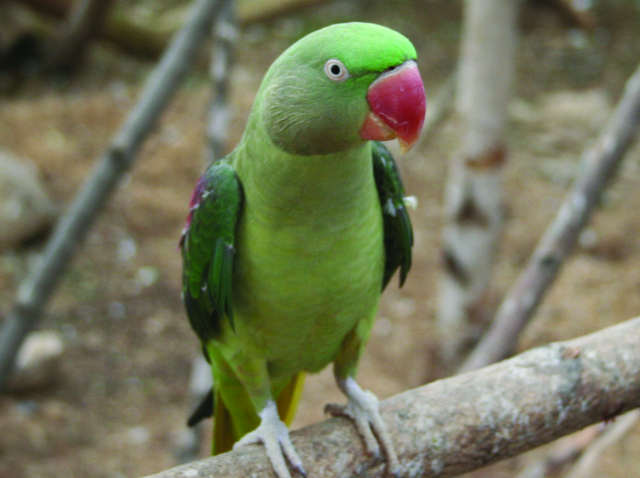Alexandrine Parakeet

Description
The Alexandrine parakeet (Psittacula eupatria), also known as the Alexandrine parrot, is a medium-sized parrot in the genus Psittacula of the family Psittacidae. It is named after Alexander the Great, who transported numerous birds from Punjab to various European and Mediterranean countries and regions, where they were prized by the royalty, nobility and warlords.
The Alexandrine parakeet has established feral populations in Spain, England, Belgium, the Netherlands, Germany, Turkey, Saudi Arabia, Bahrain, Qatar, the United Arab Emirates, Iran, Hong Kong, and Japan, where it lives alongside feral populations of its close relative, the rose-ringed parakeet (Psittacula krameri).
The Alexandrine parakeet is one of the largest parakeets, measuring 56 to 62 cm (22 to 24 in) from the top of the head to the tip of the tail and weighing 200 to 300 g (7.1 to 10.6 oz). The tail measures 28 to 35 cm (11 to 14 in). It is predominantly green with a light blue-grey sheen on the cheeks and nape (back of the neck), yellow-green abdomen, red patch on either shoulder and massive red beak with yellow tips. The upperside of the tail passes from green at the top to blue further down, and is yellow at the tip. The underside of the tail is yellow.
Adults are sexually dimorphic. Adult males have a black stripe across their lower cheeks and pink band on their nape. Adult females lack both a black stripe across their lower cheeks and a pink band on their nape. The young are similar in appearance to adult females but have shorter tails.
Scientific Name
Psittacula eupatria
Country Of Origin
India, Southeast Asia
Size
Large, 23 inches
Life Expectancy
15 to 30 years
Noise Level
Moderate
Talk / Trick Ability
Moderate
Characteristics
Alexandrine parakeets are independent but social and make excellent pets. They are adventurous and enjoy new toys and activities. While they do not enjoy as much handling as other parrots, Alexandrine parakeets do like being touched and stroked on occasion. These birds enjoy showering in the rain, so regular indoor showers or spraying them with a bottle is ideal.
Behavior / Health Concerns
Alexandrine parakeets can be noisy and a prolific chewer, so provide wooden toys. They can also be aggressive toward other birds, so it is best to house Alexandrine parakeets in separate cages. These pet birds need different bird foods, with plenty of fruit, vegetables and greens. With training, practice and patients, this parakeet can become a tame pet.